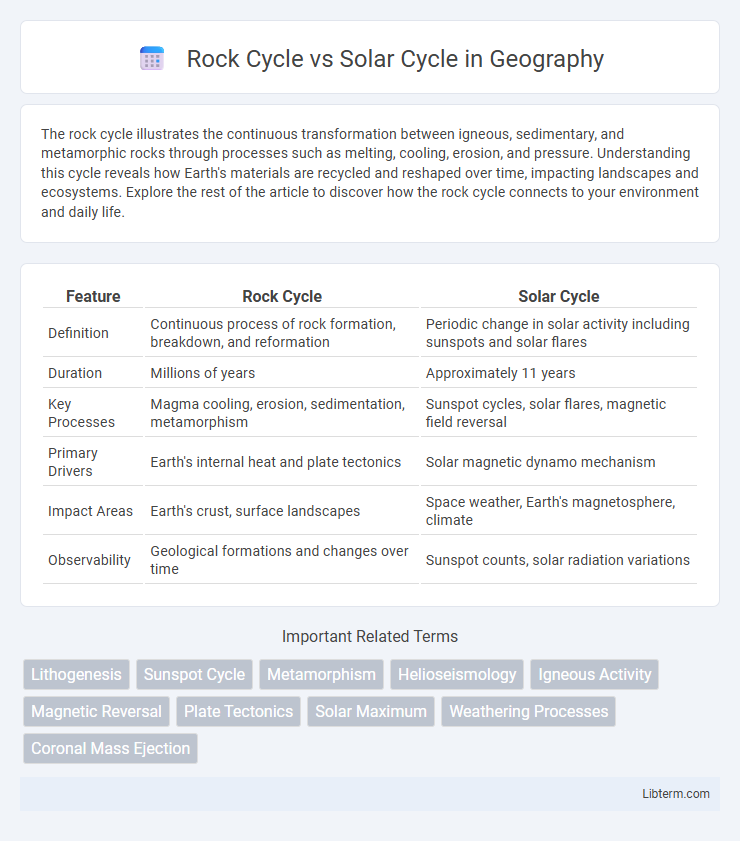The rock cycle illustrates the continuous transformation between igneous, sedimentary, and metamorphic rocks through processes such as melting, cooling, erosion, and pressure. Understanding this cycle reveals how Earth's materials are recycled and reshaped over time, impacting landscapes and ecosystems. Explore the rest of the article to discover how the rock cycle connects to your environment and daily life.
Table of Comparison
| Feature | Rock Cycle | Solar Cycle |
|---|---|---|
| Definition | Continuous process of rock formation, breakdown, and reformation | Periodic change in solar activity including sunspots and solar flares |
| Duration | Millions of years | Approximately 11 years |
| Key Processes | Magma cooling, erosion, sedimentation, metamorphism | Sunspot cycles, solar flares, magnetic field reversal |
| Primary Drivers | Earth's internal heat and plate tectonics | Solar magnetic dynamo mechanism |
| Impact Areas | Earth's crust, surface landscapes | Space weather, Earth's magnetosphere, climate |
| Observability | Geological formations and changes over time | Sunspot counts, solar radiation variations |
Introduction to the Rock Cycle and Solar Cycle
The rock cycle describes the continuous transformation of rocks through processes such as erosion, sedimentation, melting, and cooling, forming igneous, sedimentary, and metamorphic rocks. The solar cycle involves the periodic variation in solar activity, including changes in sunspots, solar flares, and solar wind, impacting space weather and Earth's climate. Understanding these cycles explains Earth's dynamic geological activity and the Sun's influence on the planetary environment.
Defining the Rock Cycle: Earth’s Geological Process
The Rock Cycle describes the continuous transformation of rocks through processes such as melting, cooling, erosion, and sedimentation, driven by Earth's internal heat and surface dynamics. This geological process involves the formation, breakdown, and reformation of three main rock types: igneous, sedimentary, and metamorphic. Unlike the Solar Cycle, which governs solar magnetic activity and sunspot fluctuations over approximately 11 years, the Rock Cycle operates over millions of years, shaping Earth's crust and landscape over geological time.
Understanding the Solar Cycle: Sun’s Rhythmic Variations
The solar cycle, lasting approximately 11 years, is characterized by the rhythmic increase and decrease of sunspots, solar flares, and coronal mass ejections driven by the Sun's magnetic field fluctuations. These variations directly impact space weather, influencing satellite communications, GPS systems, and Earth's climate patterns. In contrast to the geological rock cycle, the solar cycle reflects dynamic plasma processes and electromagnetic activity in the Sun's outer layers rather than Earth's lithospheric transformations.
Key Components of the Rock Cycle
The Rock Cycle encompasses processes such as weathering, erosion, sedimentation, compaction, and metamorphism that continuously transform igneous, sedimentary, and metamorphic rocks. Key components include magma formation, cooling and solidification, sediment transport, lithification, and heat and pressure-driven metamorphic changes. Unlike the Solar Cycle, centered on sunspot activity and solar magnetic fluctuations, the Rock Cycle focuses on Earth's internal and surface geological processes shaping the rock materials over geologic time.
Phases and Features of the Solar Cycle
The Solar Cycle spans approximately 11 years, characterized by fluctuating solar activity that includes the rise and fall of sunspots, solar flares, and coronal mass ejections. Key phases of the Solar Cycle include the Solar Minimum, marked by minimal sunspot numbers and reduced solar radiation, and the Solar Maximum, featuring peak sunspot activity and intense solar storms. These phases significantly impact space weather and terrestrial phenomena, contrasting with the Rock Cycle's geological transformations driven by igneous, sedimentary, and metamorphic processes.
Time Scales: Comparing Rock and Solar Cycles
The rock cycle operates over millions to billions of years, encompassing processes like erosion, sedimentation, metamorphism, and volcanism that continuously transform Earth's crust. In contrast, the solar cycle spans approximately 11 years, characterized by the periodic fluctuation of solar magnetic activity, sunspots, and solar radiation. Understanding these differing time scales highlights the rock cycle's role in shaping geological features across vast epochs, while the solar cycle influences space weather and Earth's climate on shorter, decadal intervals.
Influence on Earth’s Environment and Life
The rock cycle drives the continuous transformation of Earth's lithosphere, shaping habitats and influencing soil fertility vital for terrestrial ecosystems. The solar cycle, marked by fluctuating solar radiation and magnetic activity approximately every 11 years, affects Earth's climate patterns and space weather, impacting atmospheric conditions and biological rhythms. Interactions between these cycles modulate environmental stability, influencing biodiversity and ecosystem resilience on Earth.
Interconnections Between Rock and Solar Cycles
The rock cycle and solar cycle are interconnected through the influence of solar energy on Earth's geological processes. Solar radiation drives weathering and erosion, key components in transforming rocks within the rock cycle by breaking down minerals and facilitating sediment transport. Variations in the solar cycle can affect Earth's climate, indirectly impacting rates of rock formation, erosion, and metamorphism through changes in temperature and precipitation patterns.
Human Impact and Scientific Importance
The Rock Cycle illustrates the transformation of Earth's lithosphere through processes like erosion, sedimentation, and volcanic activity, with human activities such as mining and construction accelerating certain stages, impacting geological formations. The Solar Cycle, spanning roughly 11 years, governs solar activity including sunspots and solar flares, influencing Earth's climate systems and satellite communications. Understanding both cycles is critical for predicting natural hazards, mitigating human environmental impact, and advancing research in geosciences and space weather forecasting.
Conclusion: The Significance of Both Cycles
The Rock Cycle and Solar Cycle each play crucial roles in Earth's system, with the Rock Cycle driving the formation and transformation of Earth's crust, influencing landscapes and ecosystems. The Solar Cycle regulates solar radiation variability, impacting Earth's climate and space weather conditions. Understanding both cycles is essential for comprehending Earth's geological dynamics and atmospheric processes.
Rock Cycle Infographic

 libterm.com
libterm.com